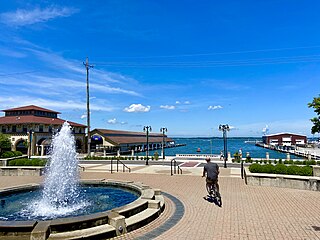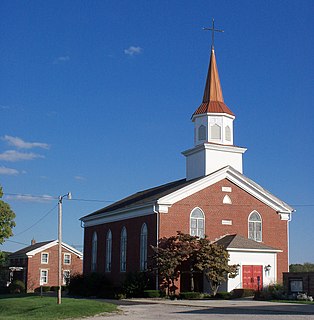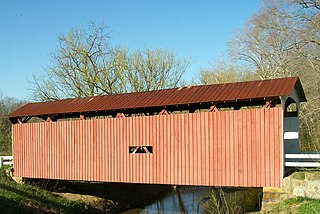
Upper Sandusky is a city and the county seat of Wyandot County, Ohio, United States, along the upper Sandusky River, which flows north to Sandusky Bay and Lake Erie. The city is approximately 59 mi (96 km) south of Toledo and 62 mi (99 km) north of Columbus. The population was 6,596 at the 2010 census. The city was founded in 1843 and named for an earlier Wyandot Indian village of the same name, which was located nearby. It was named "Upper" because it is located near the headwaters of the Sandusky River;

The Colonel Crawford Burn Site Monument is a war monument in rural Wyandot County, Ohio, United States. Placed in the 1870s, it commemorates the death by burning of Colonel William Crawford during the concluding years of the American Revolution. The stone monument itself was long the subject of local interest, and it has been named a historic site.

Armstrong Chapel United Methodist Church is a historic church in the city of Indian Hill, Ohio, United States. Built in 1831, it is a small rectangular building with a prominent front tower. It was designated a historic site in 1975.

The Great Mound is a massive Native American mound in the southwestern part of the U.S. state of Ohio. Located in Section 19 of Madison Township in Butler County, it has a height of 88 feet (27 m) and a circumference of 511 feet (156 m). Its total volume is nearly 825,000 cubic feet (23,400 m3), making it the largest mound in Butler County and one of the largest in southwestern Ohio. Because of the mound's height and its placement on a ridgeline, an individual at the summit can see for a great distance. In the late nineteenth century, it was theorized that mounds such as the Great Mound were built as observation or watch points, and that the builders maintained the ability to light fires atop the mounds as a method of communicating across wide distances. The potential of these mounds for long-distance communication was demonstrated in 1990 by three groups of volunteers. After climbing the Great Mound, the first group established visual contact with the Hill-Kinder Mound in Franklin, from which point the observers of the second group contacted the third group atop the Miamisburg Mound near Dayton.

Sandusky is a city in the U.S. state of Ohio and the county seat of Erie County. Situated in northern Ohio on the shores of Lake Erie, Sandusky is midway between Toledo to the west and Cleveland to the east.
Armstrong House, Armstrong Farm, or variations, may refer to:

St. Mary of the Immaculate Conception Church, also known as St. Mary's of Morges ) is a Roman Catholic church located in the unincorporated community of Morges in Rose Township, Carroll County, Ohio, United States. A part of the Diocese of Steubenville, it was founded in 1834 and re-established in 1948; its current building was built in 1851 and renovated in 1979. The altar was crafted in Europe and shipped to the parish late in the 19th century. The stained-glass windows were donated by parishioners in the early 1900s. The 1979 restoration involved refinishing the altar, repainting statuary and walls, and installation of new pews.

St. Joseph's Catholic Church is a historic Roman Catholic church in Wapakoneta, Ohio, United States. Built in 1910, this church is home to an active Catholic parish, and it has been declared a historic site because of its well-preserved Romanesque Revival architecture.

The Hugh T. Rinehart House is a historic house located near Uniopolis in Union Township, Auglaize County, Ohio, United States. A brick structure built in 1861, it was once the home of one of the most prominent citizens of early Auglaize County. It has been designated a historic site because of its high degree of preservation.

Precious Blood Catholic Church is a Roman Catholic parish in Chickasaw, Ohio, United States. Erected in 1903 and still an active parish, the church historically owned two buildings constructed in its early years that have been designated as historic sites.

The Minster Elementary School is a historic Catholic school building in Minster, Ohio, United States. Built in the early twentieth century, it has been recognized as a historic site.

Bear's Mill is a historic gristmill near the city of Greenville in Darke County, Ohio, United States. Built in 1849, this watermill is the oldest existing industrial building in Darke County. Built by Manning Hart, a local contractor, the mill lies along Greenville Creek in southwestern Adams Township, midway between Greenville and the village of Gettysburg. It was purchased before its completion by Pennsylvanian Gabriel Bear, who completed and opened the mill in 1849. After his locally made millstones proved faulty, Bear travelled to France, where he acquired stones of a type regarded worldwide as of highest quality.

The James and Sophia Clemens Farmstead is a historic farm in far western Darke County, Ohio, United States. It is situated at 467 Stingley Road, little more than 1 mile (1.6 km) from the Indiana border, it is among the oldest extant buildings that remain from a small community of free blacks founded before the Civil War.

The Sawyer–Curtis House is a historic residence in the community of Little Hocking in Washington County, Ohio, United States. Located along the Ohio River in southern Belpre Township below the city of Belpre, Little Hocking was settled shortly before 1800. The earliest settler in the vicinity of Little Hocking was Nathaniel Sawyer, a native of Massachusetts who erected a New England-style of house there in 1798. Now known as the Sawyer–Curtis House, it is believed to have been the first permanent structure to be erected anywhere in Belpre Township. Sawyer's house is a weatherboarded structure with a tin roof and a foundation of sandstone. Built around a frame of logs, it is constructed with a typical New England floor plan, with its most significant individual feature being a massive chimney at the center of the house.

The Walter Curtis House is a historic residence in far southern Washington County, Ohio, United States. Located south of Little Hocking, a community in southern Belpre Township, the house is a two-story structure constructed in 1827. Built of brick with elements of stone, it was the home of local politician Walter Curtis. During the nineteenth century, Curtis held such offices as Washington County Commissioner, associate judge, and Ohio state representative; his son Austin was later also elected to the Ohio House of Representatives.

The Colonel Joseph Barker House is a historic residence in Washington County, Ohio, United States. Located north of Marietta, in the Muskingum Township community of Devola, it has changed little since its construction in the early nineteenth century, and it has been designated a historic site.

The Samuel Caldwell House is a historic house in the village of Caldwell, Ohio, United States. Erected in 1832, it is the oldest house in the village.

The Root Covered Bridge is a historic wooden covered bridge in the southeastern part of the U.S. state of Ohio. Located off State Route 555 in far northern Decatur Township, Washington County, the bridge was built in 1878 in the Long truss mode of truss bridge construction. Measuring 65 feet (20 m) in its single span, it spans the West Branch of the Little Hocking River.

The Mull Covered Bridge is a historic wooden covered bridge in the northwestern portion of the U.S. state of Ohio. Built in the middle of the nineteenth century, it is located near Burgoon in Sandusky County. Although it is no longer used to facilitate transportation, the bridge has been preserved and is now a historic site.

The Overmyer–Waggoner–Roush Farm is a historic farmstead on the southern edge of the village of Lindsey in the northwestern part of the U.S. state of Ohio. Composed primarily of buildings constructed in the middle of the nineteenth century, it has been converted into a park and designated a historic site.
























